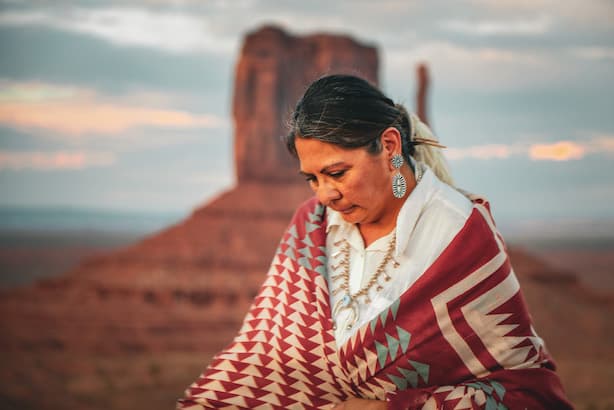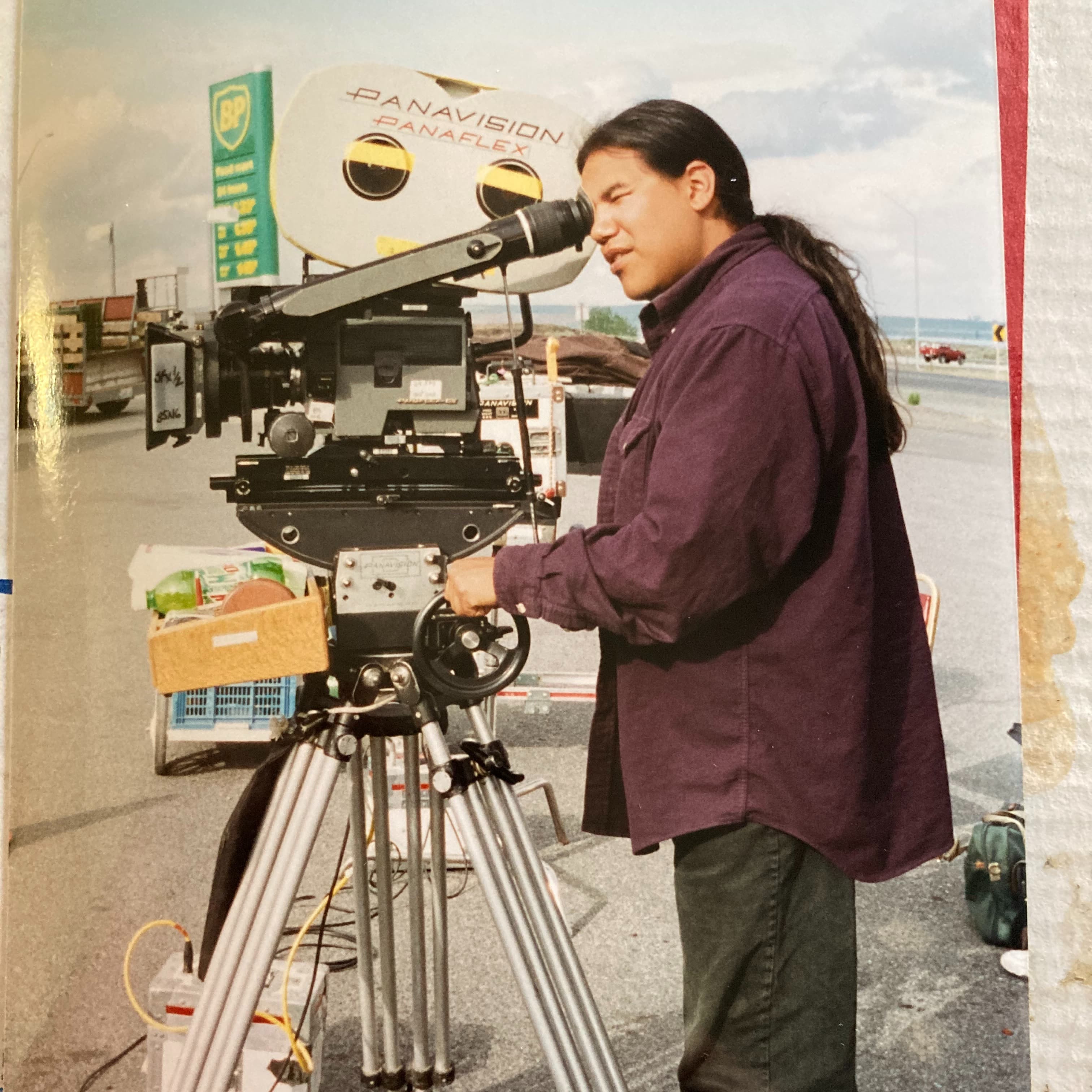
Native Narratives Can Change a Person’s Perspective of a Culture
September 2, 2025
A Navajo woman reflects on reclaiming Native identity through art while challenging Hollywood’s harmful stereotypes and advocating for authentic Indigenous storytelling.
By Pamela Peters
This essay is part of the Crocker’s Indigenous Voices in Film project, an initiative dedicated to exploring the artmaking practices of Indigenous peoples in the Sacramento and Northern California regions through the lens of film, video, and media arts. For more information on the Indigenous Voices in Film project, follow this link.
As a Navajo woman deeply passionate about the art of storytelling through various multimedia forms, including photography, film, and poetry, I firmly believe that it is crucial for Native peoples to share their narratives. This practice empowers us to influence the preservation of our rich and diverse Native history and culture.

My enthusiasm for the narratives owned by Native Americans is profoundly influenced by my childhood experiences on the reservations during the 1970s, a time when having access to a television was considered a luxury. However, my parents were able to purchase a small, used black-and-white television on which our antenna could only receive three channels in the desolate area in which we lived. Despite its limitations, this was a remarkable experience for a child living on the reservation. Saturday afternoons were filled with Western programs that featured “Cowboys and Indians” narratives, which I particularly enjoyed because it allowed me to bond with my father, who was an avid fan of Western programs. I later discovered that many Navajos shared this interest when I realized that several Navajos appeared as extras in these programs and films, including some of my own relatives. From the 1930s to the 1960s, numerous Western movies were shot on the Navajo reservations; however, it is amusing to note that Navajos were often depicted as Plains Indians, with many stories generating a landscape of the Southwest. The narrative structure surrounding the ideology of Manifest Destiny primarily centered on a singular portrayal of the savage Indian, neglecting the rich diversity present among various tribal nations. To truly grasp the complexities of these tribal nations, filmmakers needed to delve deeper into the diversity of Native cultures. However, it was often more convenient for Hollywood creators to adopt a generalized image of a Plains Indian, rather than acknowledging those from the Northern regions of the United States. For instance, filmmakers such as John Ford opted to portray Navajo people as Plains Indians from the Southwest in a simplified manner, depicting them in headdresses and residing in teepees within the iconic landscapes of Monument Valley and other areas of Arizona. The film industry laid the foundation that all Indians lived in teepees and that headdresses were part of the regalia worn by all tribal members, along with the idea that all tribal nations lived in desolate dryland, that has led the Navajo Nation to become a prominent backdrop for Western-themed films. This has transformed it into an iconic landscape that attracts many tourists from all over the world, which continues today.
Hollywood Western films remain problematic today due to their limited representation of Native peoples and lack of understanding of the complexity of tribal nations, stories, and imagery. As a child, I found it perplexing when my father expressed enthusiasm for the death of the "Indians." When I questioned him, asking, "Why are you saying that? Aren't we 'Indians?'" he would respond that they were the bad ones. Ironically, the actors portraying these characters were Navajo. Even at a young age, I sensed the confusion surrounding Native representation. I now understand that when Native individuals were depicted, it was often briefly, and heavily influenced by Hollywood stereotypes, which portrayed us as either relics of the past or as "savage" figures, leading audiences to cheer for our demise. As an adult, I came to comprehend the reasons behind my father's feelings: they stemmed from his experiences in boarding school and the necessity he perceived to abandon his cultural roots in favor of adopting Western ideologies. I understood this as I, too, encountered the same feelings. Throughout my transition from childhood to adulthood, I witnessed the widespread misrepresentation and distortion of Native narratives in both film and television, which has significantly impacted my self-identity as a Native woman. From an early age, I became increasingly aware of the inconsistencies and the lack of agency afforded to tribal nations in the stories told not only in films, but also in television series like Bonanza and Little House on the Prairie.
As a child, I grappled with the shame associated with these portrayals and sensed the overt animosity from my non-Native classmates. For instance, I would often be ridiculed by White students who would make whooping sounds and laugh as I walked past them. This animosity stemmed not only from my brown skin but also from society's broader failure to accurately depict contemporary Native individuals. I often felt that my mere existence as a real, modern Native person was dismantling the fantasy constructed by Hollywood's representations of Indian identity, a heavy burden to carry at such a young age, and one that continues to affect societal perceptions today.
The capacity to convey Native stories through an Indigenous perspective is essential. Historically, the portrayal of Native peoples in film has often been generated by damaging narratives within Western cinema. Regrettably, even with the emergence of new period pieces reflecting Western ideologies, the representation of Native individuals in Hollywood remains largely unchanged. Productions such as Horizon by Kevin Costner and Taylor Sheridan's series 1883, 1923, and Yellowstone continue to adhere to a White patriarchal framework, failing to incorporate Native voices or capture the complexities of Indigenous lives. Instead, these films and series predominantly depict the ongoing narrative of White settlers encroaching upon Native lands. Unfortunately, the series overlook the opportunity to allow Native writers to present the authentic stories of Indigenous nations facing encroachment on their ancestral territories.
Recently, however, there has been a notable shift in Native representation, particularly with the proliferation of streaming platforms such as Roku, Amazon, and Google TV. These platforms have introduced series like Reservation Dogs and films such as Frybread Face and Me, which not only showcase Native representation but also present contemporary narratives that are crucial for Native communities, especially our Native youth. The availability of such programs brings a sense of positive change, as it allows young Native children to see themselves reflected in the media, signaling a growing societal recognition of contemporary Native identities.
Throughout the years, I have utilized multimedia access to present a positive and accurate narrative based on my direct experiences and observations, which have significantly impacted both my life and that of my Native community. My artistic journey began as a photographer, where I aimed to provide authentic representations of Native peoples. This endeavor evolved to include giving a voice to the images I captured and fostering a collective connection that allowed these visuals to narrate their own stories. It has been essential for me to create authentic and diverse imagery and articulate the narratives behind who and what I was showcasing. Over the years, the Native community has advocated for more genuine and varied representations of Native America across all forms of artistic expression, including film and poetry. This effort is crucial as Native individuals strive to reclaim our narrative and challenge the misconceptions perpetuated by non-Native artistic expressions. For instance, as a photographer this past year, I displayed more than 10 billboards across Los Angeles featuring individuals representing their tribal nations, with the hashtag #NativeNationsInLA. This initiative aimed to educate the city about the rich diversity of the tribal nations that are part of Southern California's cultural landscape. Furthermore, for the last six years, I have been highlighting the diversity of tribal nations through poetry readings, as poetry plays a crucial role in conveying the resilience and creativity inherent in these communities.
Native American representation in poetry has similarly been a subject of considerable debate, as numerous poets strive to authentically express the intricacies of Indigenous identity and history in their work. While some Native poets have successfully elevated tribal voices and perspectives, others have unfortunately fallen into the pitfalls of cultural appropriation and misrepresentation, often aligning with the expectations of a predominantly White audience. In response to this, I developed a series entitled Waging Words, where poets from various tribal nations engage audiences to comprehend the history, landscape, and contemporary issues affecting Native communities. Addressing issues such as Murdered and Missing Indigenous relatives, cultural appropriation in popular culture, and the resilience of Native communities is essential for an audience to comprehend the challenges faced by Native peoples today. It is important to engage with these perspectives from Native voices and advocate for a marginalized community. For instance, Kelly Caballero, a poet from the Tongva tribe, presented a poem entitled “City Indians,” in which she emphasized that it transcended a mere performative acknowledgment of the land; it was about engaging with and comprehending the origins of the land and its original inhabitants of what is known as Tovaangar, a.k.a. Los Angeles. This illustrates how Native voices expressed through poetry provide a nuanced understanding of tribal nations, characterized by respect, authenticity, and a focus on the voices that shape the landscape. Consequently, poetry can act as a powerful tool for dismantling stereotypes and contesting dominant narratives surrounding Native American communities, similar to the initiatives undertaken by numerous Native filmmakers today.
The land is the essence of our Native soul, not a concession stand for Hollywood fantasies. Since my transition from Los Angeles to the Navajo Nation, my connection to the land has deepened, and my perspective on its significance has evolved now that I have returned to my homeland in Arizona. Living here has allowed me to re-examine the meaning of this land as a tribal woman, transcending the representation often depicted by Hollywood, and has motivated me to pursue more writing. I would like to share a brief poem and express my aspiration to create more narratives from an Indigenous viewpoint.
Our land is red, due to the strength of my ancestors who bravely evaded the cannons in their lifetime, paving the way for my existence today.
Our land is red, as a reminder of my ancestors who fought to survive on this soil, enduring hunger so I could experience the richness of life today.
Our land is red, marked by the bloody feet walking through the dreadful heat, paving the way for my future.
Hollywood, recognize that our land is not just a canvas for your stories; it is alive and lives within us — within me!
The Indigenous Voices in Film series explores and highlights the work of Indigenous peoples at the intersection of film, video art, and media arts. Supported by a generous grant from the Terra Foundation for American Art to broaden the understanding of American art history, this project is committed to presenting films and video art created by Indigenous peoples, as well as to advancing critical discussion of these works in the region and within the museum field.
